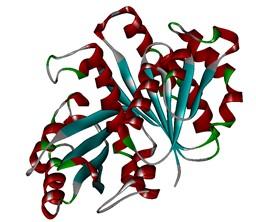In silico drug design for inhibiting the cell division of Mycobacterium tuberculosis and suppressing its growth based on high-precision molecular simulations

Credit: COPYRIGHT (C) TOYOHASHI UNIVERSITY OF TECHNOLOGY. ALL RIGHTS RESERVED.
Overview:
The research team of the Department of Computer Science and Engineering at the Toyohashi University of Technology and the Institute of Food Biotechnology and Genomics at the National Academy of Sciences of Ukraine have proposed a new drug to treat tuberculosis (TB), utilizing the state-of-the-art molecular simulations. This drug may inhibit the cell division of Mycobacterium tuberculosis (M. tuberculosis) and suppress its growth. In addition, because this drug acts on the enzymes secreted by M. tuberculosis instead of acting on M. tuberculosis itself, M. tuberculosis has very little chance of mutation and develops no drug resistance. Therefore, it is expected that this drug will lead to a novel drug that will keep its effectiveness for a long time.
Details:
Currently, the global spread of COVID-19 caused by the novel coronavirus has become a major social issue. Similarly, TB caused by M. tuberculosis is also one of the most dangerous infectious diseases in the world to date, and various drugs used to treat TB have been developed. However, as the M. tuberculosis easily mutates, its new mutants have a possibility to retain a resistance against the existing drugs, resulting in making them ineffective. This fact is a major bottleneck to further development of TB drugs.
Therefore, to prevent the occurrence of this drug resistance, drugs that act on the enzymes secreted by M. tuberculosis instead of M. tuberculosis itself are being developed. In this research, we targeted the cytoskeletal protein FtsZ, which is essential for M. tuberculosis to perform cell division, and by inhibiting that function, we aimed to develop a new drug that inhibits the cell division of M. tuberculosis and suppresses its growth. For this purpose, we used the state-of-the-art and high-precision molecular simulation method developed by our research group to analyze the binding properties between FtsZ and the various compounds that are drug candidates. Based on the results simulated, we proposed the compound that binds more strongly to FtsZ as a new drug to treat TB.
Development Background:
Master’s student and lead author of this paper, Shohei Yamamoto, reflects on that time below. “Because the FtsZ protein targeted in this research has many positions where compounds can bind to it, we had difficulty identifying the positions of the FtsZ protein in which the compounds considered as drug candidates would bind most strongly in the molecular simulation. I think that being able to solve this matter led to the proposal of a therapeutic drug for TB.”
In addition, the research team’s leader, Associate Professor Noriyuki Kurita, recounts how the research began below. “This research is a collaboration with my old friends at the National Academy of Sciences of Ukraine. I remember about five years ago, when I visited a laboratory in Kyiv, Ukraine and was first introduced to a protein called FtsZ, I answered that its structure was too complex and that it would be difficult to investigate its binding properties with drug-like compounds in our molecular simulations. However, my friends asked me several times to start the calculations, and finally our intimate collaboration study started. I think that Eastern European researchers tend to thoroughly pursue difficult research themes even if it takes a long time, and that there are many things that we could learn from how they proceed with their research.”
Future Outlook:
Currently, we are requesting that the compound proposed in this paper be synthesized in a Ukrainian laboratory and the effects be investigated by cell experiments, but due to the economic situation of the other party, it seems that this will take time to realize. In addition, the molecular simulation method used in this research can be applied to other proteins, and we are currently conducting calculations with the aim of proposing new inhibitors for the proteins of the novel coronavirus.
This research was carried out through an international internship program supported by the Japan Student Services Organization (JASSO), student exchange and research exchange programs between the Toyohashi University of Technology and the Institute of Food Biotechnology and Genomics at the National Academy of Sciences of Ukraine. We would like to thank Professor Yaroslav Blume, Professor Sergey Shulga, and Doctor Karpov Pavel of the National Academy of Sciences of Ukraine for providing valuable information in advancing this joint research.
###
Reference:
“Design of potent inhibitors against bacterial cell-division protein FtsZ: molecular docking and ab initio molecular orbital calculations”, Yamamoto, S.; Saito, R.; Nakamura, S.; Sogawa, H.; Karpov, P.; Shulga, S.; Blume, Y.; Kurita, N., Antibiotics, 2020, 9, 846; doi:10.3390/antibiotics9120846.
“Binding sites of Zantrin inhibitors to the bacterial cell division protein FtsZ: molecular docking and ab initio molecular orbital calculations”, Sogawa, H.; Sato, R.; Suzuki, K.; Tomioka, S.; Shinzato, T.; Karpov, P.; Shulga, S.; Blume, Y.; Kurita, N., Chemical Physics, 2020, 530, 110603.
Media Contact
Yuko Ito
[email protected]
Related Journal Article
http://dx.




